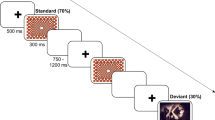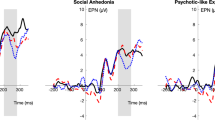Abstract
Contingent negative variation and evoked potentials to visual erotic stimuli were recorded from 8 brain sites in a sample of 62 right-handed men aged 20–50, half of whom declared paraphilic interests and half claimed “normal” heterosexual interests. To quantify erotic preferences, a “variance quotient” (VQ) was calculated from scores on the Wilson Sex Fantasy Questionnaire using the formula VQ = Impersonal + Sadomasochistic fantasies/Intimate + Exploratory fantasies. Stimuli consisted of 57 paraphilic slides (depicting fetishistic and sadomasochistic themes), 57 heterosexual erotic slides (explicit pictures of nude women, coitus, and oral sex), and 57 neutral slides (landscapes and street scenes). The P600 response appeared to be the best indicator of erotic preferences, but the locus of maximum arousal was different for paraphilic and heterosexual stimuli. The primary brain site for heterosexual arousal was P4 (right parietal), where there was a −.34 (p < .01) correlation between VQ and P600 (i.e., nonvariant males showed greater responses to normal erotic stimuli at this location). For paraphilic stimuli, there was a correlation of .26 (p < .05) between the VQ and P600 response at the F3 (left frontal) site (i.e., paraphilic men showed greater responses to paraphilic stimuli than normal men at this brain location). Dividing the sample into groups of 23 paraphilics and 23 heterosexual controls on the basis of their VQs showed that “normals” differentiated between stimulus types more at the P4 than paraphilics. Theoretical and clinical implications of these findings are discussed.
Similar content being viewed by others
REFERENCES
Arnow, B. A., Desmond, J. E., Banner, L. L., Glover, G. H., Solomon, A., Polan, M. L., et al. (2002). Brain, 125, 1014–1023.
Bocher, M., Chisin, R., Parag, Y., Freedman, N., Weil, Y. M., Lester, E., et al. (2001). Cerebral activation associated with sexual arousal in response to a pornographic clip: A 15O-H2O PET study in hetero-sexual men. NeuroImage, 14, 105–117.
Carlson, N. R. (1994). Physiology of behavior (5th ed.). Boston: Allyn and Bacon.
Cohen, A. S., Rosen, R. C., & Goldstein, L. (1985). EEG hemispheric asymmetry during sexual arousal: Psychophysiological patterns in responsive, unresponsive and dysfunctional males. Journal of Ab-normal Psychology, 94, 580–590.
Comarr, A. E. (1970). Sexual function among patients with spinal cord injury. Urologia Internationalis, 25, 134–168.
Costell, R. M., Lunde, D. T., Kopell, B. S., & Wittner, W. K. (1972). Contingent negative variation as an indicator of sexual object pref-erence. Science, 171, 718–720.
Dekker, J., & Everaerd, W. (1989). Physiological determinants of sexual arousal: A review. Behavior Research and Therapy, 27, 353–364.
Diedrich, O., Naumann, E., Maier, S., Becker, G., & Bartussek, D. (1997). A frontal positive slow wave in the ERP associated with emotional slides. Journal of Psychophysiology, 11, 71–84.
Flor-Henry, P. (1989). On the cerebral neurophysiology and neurotrans-mitter determination of sexual deviations. International Review of Psychiatry, 1, 83–86.
Flor-Henry, P., Lang, R. A., Koles, Z. J., & Frenzel, R. R. (1988). Quan-titative EEG investigations of genital exhibitionism. Annals of Sex Research, 1, 50–62.
Flor-Henry, P., Lang, R. A., Koles, Z., & Frenzel, R. (1991). Quantitative EEG studies of pedophilia. International Journal of Psychophysi-ology, 10, 253–258.
Howard, R. C., Longmore, F. J., & Mason, P. A. (1992). Contingent nega-tive variation as an indicator of sexual object preference: Revisited. International Journal of Psychophysiology, 13, 185–188.
Howard, R. C., Longmore, F. J., Mason, P. A., & Martin, J. L. (1994). Contingent negative variation (CNV) and erotic preference in self-declared homosexuals and in child sex offenders. Biological Psy-chology, 38, 169–181.
Lifshitz, K. (1966). The average evoked cortical response to complex visual stimuli. Psychophysiology, 3, 55–68.
Puce, A., Andrews, D. G., Berkovic, S. F., & Bladin, P. F. (1991). Visual recognition memory: Neurophysiological evidence for the role of temporal white matter in man. Brain, 114, 1647–1666.
Redoute, J., Stoleru, S., Gregoire, M., Costes, N., Cinotti, L., Lavenne, F., et al. (2000). Brain processing of visual sexual stimuli in human males. Human Brain Mapping, 11, 162–177.
Tucker, D. M., & Dawson, S. L. (1985). Asymmetric EEG changes as method actors generated emotions. Biological Psychology, 19, 63–75.
Walter, W. G., Cooper, R., Aldridge, V. J., McCallum, W. C., & Winter, A. L. (1964). Contingent negative variation: An electric sign of sensorimotor association and expectancy in man. Nature, 203, 380–384.
Wilson, G. D. (1988). Measurement of sex fantasy. Sexual and Marital Therapy, 3, 45–55.
Wilson, G. D. (1993). The psychology of male sexual arousal. In A. Gregoire & J. P. Pryor(Eds.), Impotence: An integrated approach to clinical practice (pp. 15–28). Edinburgh: Churchill-Livingstone.
Wilson, G. D., & Gosselin, C. C. (1980). Personality characteristics of fetishists, transvestites and sadomasochists. Personality and Indi-vidual Differences, 1, 289–295.
Author information
Authors and Affiliations
Corresponding author
Rights and permissions
About this article
Cite this article
Waismann, R., Fenwick, P.B.C., Wilson, G.D. et al. EEG Responses to Visual Erotic Stimuli in Men with Normal and Paraphilic Interests. Arch Sex Behav 32, 135–144 (2003). https://doi.org/10.1023/A:1022448308791
Issue Date:
DOI: https://doi.org/10.1023/A:1022448308791




